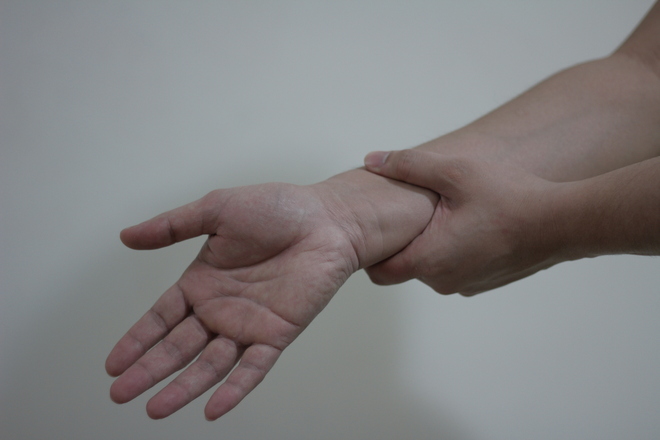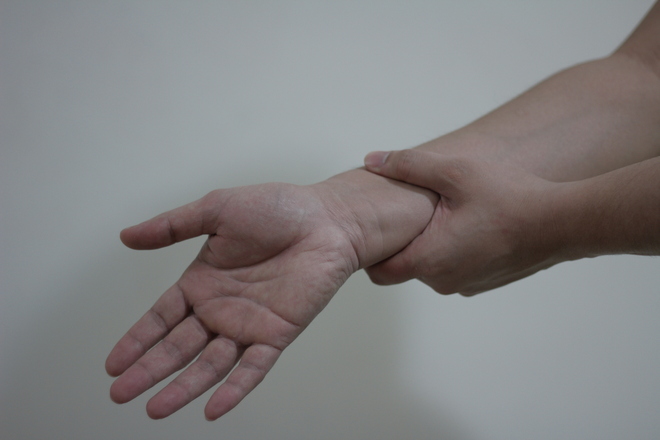Osteopathic Manipulative Medicine for Carpal Tunnel Syndrome
The Journal of the American Osteopathic Association March 2012, Vol 112, 127-139
Siu G, Jaffe JD, Rafique M,et al
The authors are osteopathic physicians and state that osteopathic medicine can be useful in diagnosing and managing carpal tunnel syndrome (CTS) via an osteopathic structural examination and osteopathic manipulative treatment.

Changes in the local anatomy can lead to CTS, such as subluxation of the lunate or a ganglion cyst. Conditions such as rheumatoid arthritis, pregnancy, diabetes can increase pressure in the carpal tunnel.
The most common clinical examination tests for CTS include Phalen’s and Tinel’s.
However, these tests have low sensitivity (60-75%) and low specificity ( 47-67%). A symptom diagram has a sensitivity of 96% and a specificity of 76% in diagnosing CTS. The gold standard is nerve conduction studies with a sensitivity of 85% and specificity > 95%.
The manual portions of the examination aspects proposed by the authors include wrist mobility and range of motion assessment including fanning and folding of the volar wrist. The carpal bones should be examined for position and carpal glide, with a focus on the lunate. Since the transverse carpal ligament (TCL) attaches to the hamate, pisiform, scaphoid and trapezium, these bones should also be examined for displacement. The Carpal-metacarpal (CMC) joints should be examined as a dysfunction can cause a change in carpal position/alignment. The radio ulnar joints and interosseous membrane should be examined as radius and ulnar positioning can affect the position of the carpals.
The authors describe manual interventions to treat CTS. They describe myofascial release to the flexor retinaculum and interosseous membrane, and a soft tissue stretch to the opponens pollicis and TCL. A high velocity low amplitude technique can be applied to the dysfunctional carpal bone. They describe an axial traction high velocity technique to the CMC and metacarpal phalangeal joints and a high velocity technique to the radial head.
Outcomes are positive for the patients receiving conservative care as conservative management works for 80% of patients with CTS. However, 80% of successful cases will have recurrence within the year. There are limited studies looking at the effectiveness of osteopathic manipulative treatment for patients with CTS. Manual intervention for patients with CTS may be overlooked.
WHY THIS MATTERS:
In many ways, substituting “orthopedic manual therapy” in the place of “osteopathic manipulation” in this article would be appropriate.
Manual physical therapists are trained to evaluate for the presence of abnormal joint alignment, abnormal joint motion, and soft tissue restrictions.
The recommended osteopathic interventions as described in this article are techniques done by manual physical therapists as well.
The article is a good reminder to market our skills as manual therapists and as the article states about osteopathic intervention, we too “may ultimately prevent or delay surgical intervention in patients with this condition”. We need to educate the public to try skilled orthopedic manual therapy before surgical intervention.
There are very little studies published addressing or describing manual physical therapy interventions for patients with CTS. I would encourage manual therapists to publish a case report describing successful manual therapy use for a patient with CTS. That is one way to advertise our expertise within the health care community. Manual physical therapy is underused and overlooked in the management of CTS. Let’s promote our skills and change that.
For more on this topic, reserve your spot one of our Upper Extremity Courses offered in Annville, Pennsylvania or NYC in January!
 Pam Kikillus, PT, DSc, OCS, COMT, FAAOMPT, CHT
Pam Kikillus, PT, DSc, OCS, COMT, FAAOMPT, CHT
NAIOMT Clinical Faculty Instructor


Year of article reads March 2102, I think you meant 2012?
LikeLike
Ha yep! Thanks 😉
LikeLike